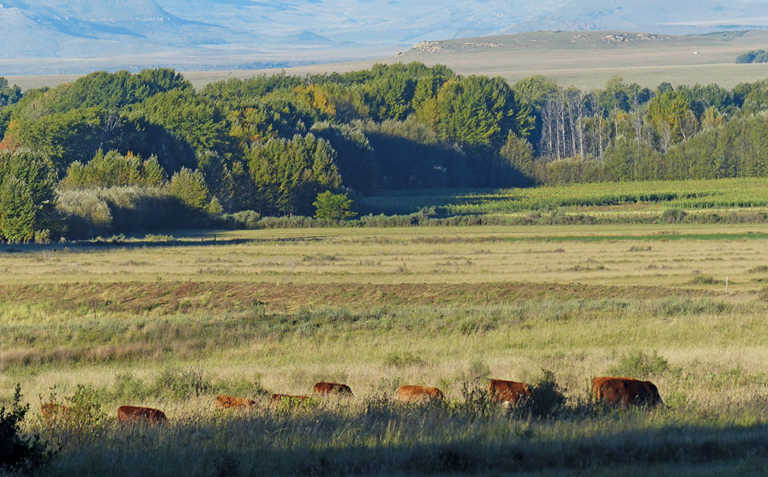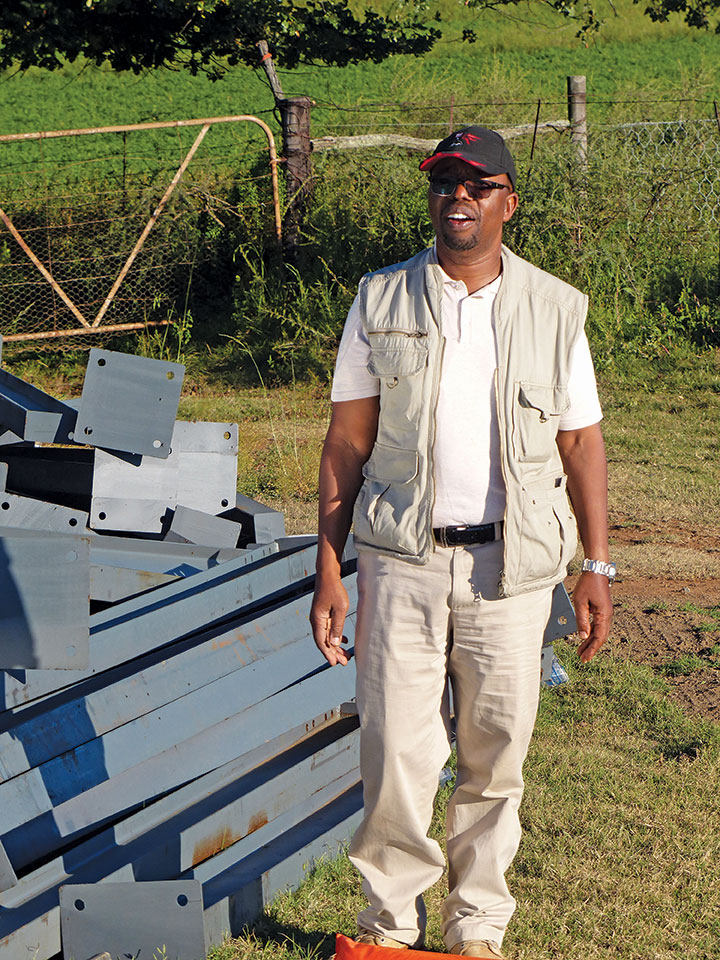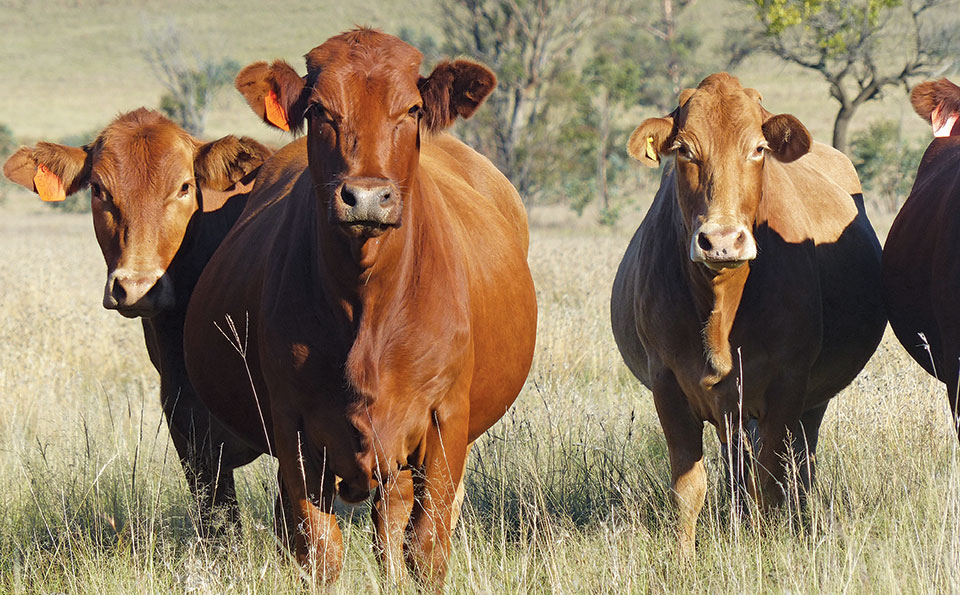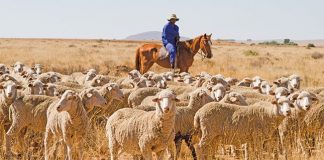
Photo: Mike Burgess
“I couldn’t fold my arms and wait for the government to do things for me,” says Aggrey Mahanjana, the managing director of the National Emergent Red Meat Producers’ Organisation (Nerpo).
“If I did, I’d have been counted among the failed land reform beneficiaries.”
Since taking control of the 5 000ha Carnarvon Estates land reform farm near Sterkstroom in the Eastern Cape, Mahanjana has personally invested no less than R18 million on a property for which he has no title deed.
READ Land: access vs ownership
The government purchased Carnarvon Estates from the Halse family in 2006 as part of its Land Redistribution for Agricultural Development programme. It was then given to the 23 farmworkers who had previously been employed there.
The initiative began to flounder, however, and when the land redistribution programme became the Proactive Land Acquisition Strategy (PLAS) in 2009, Mahanjana was asked by the Chris Hani regional Department of Rural Development and Land Reform to take over.
It has been a hard journey, and only recently has he managed to break even. He has 500 beef cows and 3 000 dual-purpose Dohne Merino ewes, and this year held his first successful on-farm auction of 198 cattle and 206 sheep.
The farm also has a vibrant hunting-agritourism enterprise, launched by the previous owners, and the future is looking brighter.
The right man
Mahanjana’s qualifications and experience made him the ideal person to take over the troubled operation. He has a master’s degree in animal production from the University of Pretoria, and was a former extension specialist and agricultural college principal.
Nonetheless, he was well aware of the challenges ahead. He admits he would have preferred to buy the property to gain ownership, but decided to bite the bullet when the 23 farmworkers agreed to a set monthly salary rather than owning or having any form of control over the farm.

“Anything that belongs to everybody belongs to nobody,” he says. “That’s why most land reform initiatives fail.”
From the start, Mahanjana suffered serious setbacks. In 2009, just before he took over, three-quarters of the property burnt down.
Soon after, he was told that the water from a dam on the farm that the previous owners had sold to the local Sterkstroom Municipality was a national asset and would no longer be paid for.
The R1,2 million a year that the Halses had earned from this resource would have been very welcome, says Mahanjana, considering that he received no state support at any stage.
In fact, according to PLAS, he had to pay the state an annual rental fee for Carnarvon Estates, calculated as a percentage of the selling price.
Mahanjana was therefore under no illusion that his venture would be a long-term, ‘generational’ project. “I’m the first generation. So I gave myself 10 to 20 years to establish things. By the third generation, it should be more plain sailing,” he says.
Taking control
Because the state decided not to buy the farm as a going concern, the Halses had sold off most of the livestock and equipment. However, Mahanjana did manage to buy some old machinery and 60 dairy and 30 beef Shorthorn cattle from them.
He sold off the dairy cattle and augmented the beef herd with 60 Nguni and Bonsmara cows he had been running on leased land in Limpopo.
Although Mahanjana was entitled to benefit from the Recapitalisation and Development Programme (RECAP), this never materialised as the process was either hijacked by corrupt bureaucrats or strangled by red tape.
“Unfortunately, if they looked in your eyes and saw that you weren’t the type of person who’d give them a brown envelope, they would never RECAP you. In addition, the red tape of getting RECAP made things impossible, as 10 committees were involved in assessing your application before the minister himself signed for approval.”
Needing to continue working in Johannesburg to ensure cash flow for the farm, Mahanjana at first appointed a series of managers to drive the initiative between his fortnightly visits.
This had disastrous consequences.
“I paid them each between R10 000 and R20 000 a month but I was losing livestock and materials through theft,” he recalls.
Desperate for a solution, he asked his sister, Zoliswa, for help. Despite having completed an agricultural diploma at Fort Cox Agricultural College in the Eastern Cape, Zoliswa was at that stage living in Sandton.
“She was shocked when I asked her. But after a few years she was passionate about it,” Mahanjana says.
Zoliswa proved to be ideal: a trustworthy partner who had the family’s interests at heart.
The operation today
Mahanjana cultivates dryland lucerne (50ha), sorghum (20ha), maize (30ha) and barley/oats (30ha) under irrigation to support his growing livestock enterprise. He runs about 500 breeding cows, predominantly commercial Beefmasters.
READ Precision breeding with extensively farmed Merinos
The Nguni, Bonsmara and Shorthorn types are being phased out. A large proportion of the Beefmaster genetics were bred from 200 females bought in 2010.
Calving takes place from August to October, and calves are weaned at eight months at an average weight of 220kg.

The sheep component comprises 3 000 Dohne Merino ewes produced from a flock of 180 young ewes and five rams purchased in 2010. A few years later, Mahanjana bought another 200 young Dohne ewes. To ensure cash flow, lambing is planned for autumn and spring, while shearing takes place twice a year, in February and October.
A number of the ewes are put to SA Mutton Merino rams in a terminal crossbreeding programme to boost lamb weights. The lambs are finished off on irrigated pastures before being marketed, but Mahanjana is in the process of building a feedlot for rounding off 1 000 lambs per cycle.
The farm’s hunting-agritourism initiative is also growing. Mahanjana has improved the access road to the isolated Stagger Inn game lodge, nestled below rugged hill country,
where game, including Barbary sheep, attracts international hunters.
Email Aggrey Mahanjana at [email protected].











